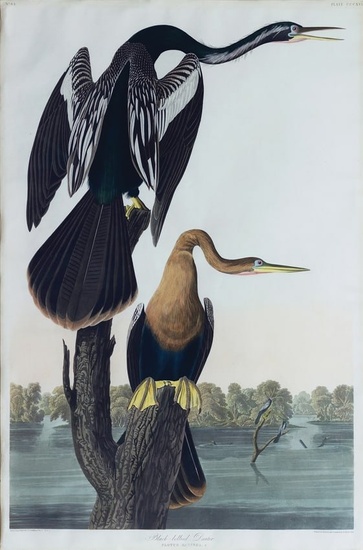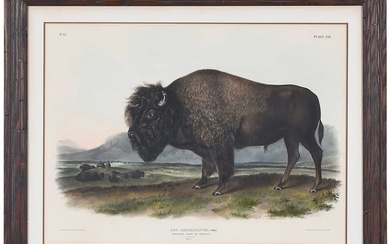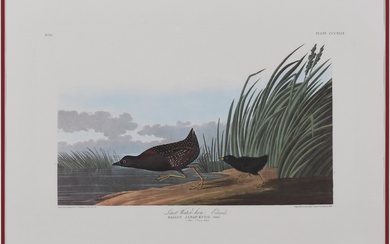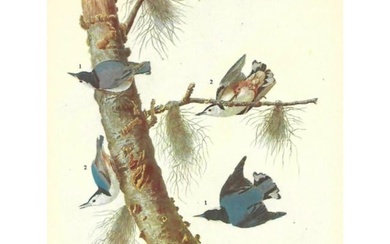Audubon Aquatint, Black-Bellied Darter or Anhinga
AUDUBON, John James (1785 - 1851).
Black-Bellied Darter [Anhinga], Plate 316.
Aquatint engraving with original hand color.
London: Robert Havell, 1827-1838.
38" x 24 3/4" sheet, 50" x 37" framed.
Comparables: Arader, 2014 - $42,700; Christie's, 2004 - $38,246.
"This was my father's favorite Audubon in his Radnor, Pennsylvania home." - Graham Arader.
One of Audubon's most imposing compositions from his monumental Birds of America, published in 4 volumes between 1827 and 1838. "I may here at once tell you that all the roosting places of the Anhinga which I have seen were over water... and this situation they seem to select because there they can enjoy the first gladdening rays of the morning sun or bask in the blaze of its noontide splendour... [They] stand erect, with their wings and tail fully or partially spread out in the sunshine, whilst their long slender necks and heads are thrown as it were in every direction by the most curious and sudden jerks and bendings." (Audubon, Birds of America [1870-71], vol.VII,pp.156-157). "Just prior to breeding, Anhingas engage in the act of 'peering around,' in which the birds, sitting upright, partially extend their heads and necks and then look slowly and repeatedly to the left and right. The S-shaped curve clearly visible in this species's neck exists because of a modification in the Anhinga's eighth and ninth vertebrae, which, together with the specialized musculature, allows the bird to dart its neck out quickly, while swimming underwater with its large, fully webbed feet, and spear a fish. ... Anhingas' feathers are not waterproof, and the birds must dry them out frequently to keep them from becoming water-logged. Thus they choose feeding areas near trees with open branches where they can conveniently perch and roost, spreading their wings to allow the water to disperse" (C.A. Slatkin in John James Audubon, The Watercolors for the Birds of America New York: 1993, p.124).
View it on
Estimate
Reserve
Time, Location
Auction House
AUDUBON, John James (1785 - 1851).
Black-Bellied Darter [Anhinga], Plate 316.
Aquatint engraving with original hand color.
London: Robert Havell, 1827-1838.
38" x 24 3/4" sheet, 50" x 37" framed.
Comparables: Arader, 2014 - $42,700; Christie's, 2004 - $38,246.
"This was my father's favorite Audubon in his Radnor, Pennsylvania home." - Graham Arader.
One of Audubon's most imposing compositions from his monumental Birds of America, published in 4 volumes between 1827 and 1838. "I may here at once tell you that all the roosting places of the Anhinga which I have seen were over water... and this situation they seem to select because there they can enjoy the first gladdening rays of the morning sun or bask in the blaze of its noontide splendour... [They] stand erect, with their wings and tail fully or partially spread out in the sunshine, whilst their long slender necks and heads are thrown as it were in every direction by the most curious and sudden jerks and bendings." (Audubon, Birds of America [1870-71], vol.VII,pp.156-157). "Just prior to breeding, Anhingas engage in the act of 'peering around,' in which the birds, sitting upright, partially extend their heads and necks and then look slowly and repeatedly to the left and right. The S-shaped curve clearly visible in this species's neck exists because of a modification in the Anhinga's eighth and ninth vertebrae, which, together with the specialized musculature, allows the bird to dart its neck out quickly, while swimming underwater with its large, fully webbed feet, and spear a fish. ... Anhingas' feathers are not waterproof, and the birds must dry them out frequently to keep them from becoming water-logged. Thus they choose feeding areas near trees with open branches where they can conveniently perch and roost, spreading their wings to allow the water to disperse" (C.A. Slatkin in John James Audubon, The Watercolors for the Birds of America New York: 1993, p.124).







